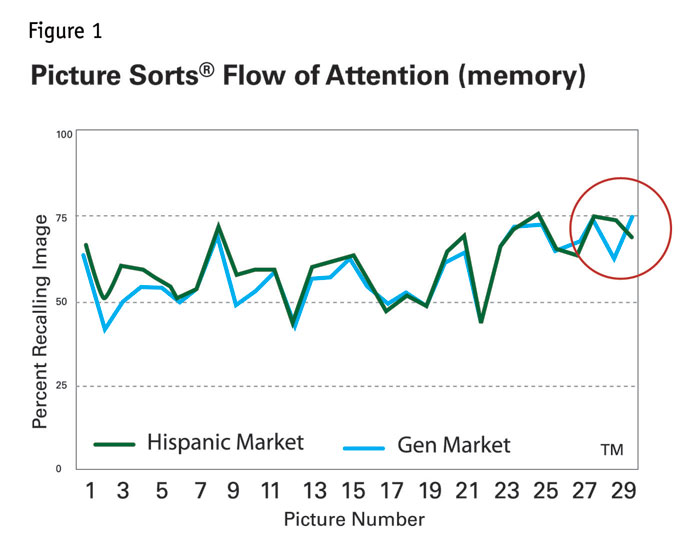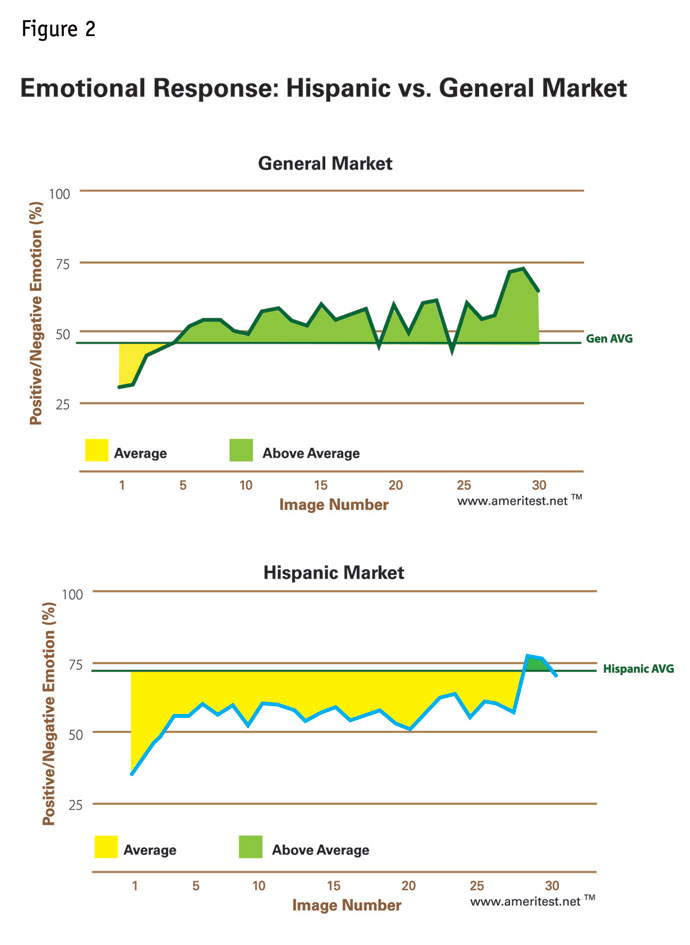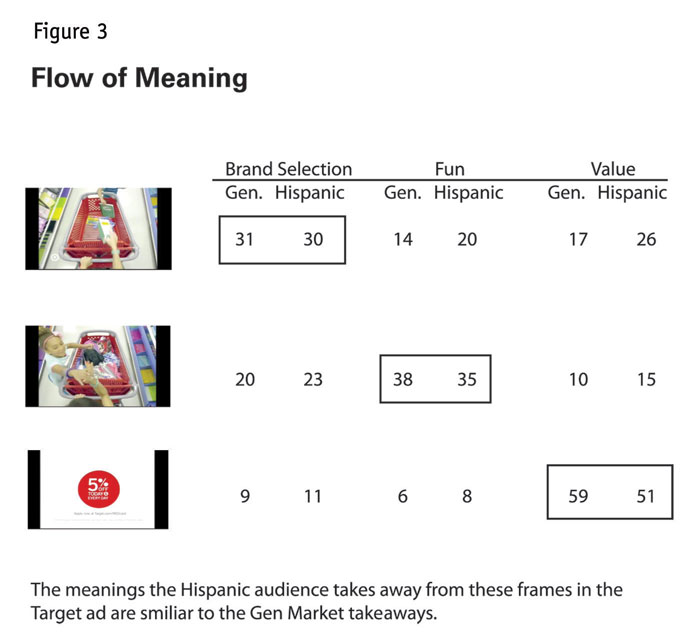Editor's note: Charles Young is founder and CEO of Ameritest, an Albuquerque, N.M., research firm.
Advertising targeted to Hispanic consumers, one of the largest and fastest-growing segments of the U.S. population, will certainly increase steadily over the next few years. But it has been difficult for researchers trying to measure or predict how advertising will perform against this important audience. This is particularly true for the subsegment of the Hispanic audience known as the unacculturated – Spanish-speakers who have not been fully integrated into mainstream U.S. culture.
Three factors are primarily responsible for the difficulties researchers have in testing Hispanic-targeted ads. The first is the problem of obtaining a reliable sample for quantitative research among this hard-to-reach group. The second problem is that of measurement – or, more specifically for pre-testing advertising, how to properly calibrate the Hispanic audience’s different use of rating scales so that they can be properly interpreted in comparison with performance metrics for the general market. The third problem is that of translation or how to capture the emotional nuances of Hispanic-targeted ads.
The large panel companies that are hard at work gradually building panels of Hispanic consumers to interview are solving the first problem. The breakthrough in this area is likely to come from the emergence of mobile research, i.e., data collection on mobile devices such as smartphones and tablets. In trying to design a representative sample for a survey it is much easier to reach a typical unacculturated Spanish-speaking consumer on an Android phone than on a desktop computer. The challenge, of course, is creating an ad test interview that works well on a mobile device.
The second problem of calibrating measurements arises from the well-known Hispanic tendency to use the more positive end of rating scales in expressing their opinions. For report-card measures such as attention and motivation, Hispanic averages are 20-80 percent higher than the averages for the general market. And for diagnostic ratings some gaps are even larger but vary depending on the item being rated.
A solution for this is to test a large enough number of ads against a Hispanic audience to have a stable database of norms. But this really only solves part of the problem. Given that the average ad tested among Hispanics is found “likeable” by 83 percent of respondents or that the average ad is found “entertaining” by 78 percent of respondents, that does not leave a lot of headroom for discriminating between strong ads and only average ads.
Using rating statements alone to diagnose the performance of an ad, nine out of 10 Hispanic respondents would have to say they like an ad or find the ad to be entertaining for that ad to score “significantly” above average on a copy test. To creatives working in Hispanic ad agencies, this must seem to be a pretty high bar of commercial performance.
The third problem, translation, reminds me of the urban legend about the marketing blunder of Chevrolet introducing a new car into Mexico where it did not realize that “nova” translates as “doesn’t go” in Spanish.
Not the only way to communicate
In the visual age of YouTube, Pinterest, Instagram and Snapchat, we are reminded that verbal language is not the only way to communicate with consumers about their thoughts and feelings about advertising. Rating statements, whether in English or Spanish, while not exactly a thing of the past, are finally revealed for what they really are – only a limited and partial window into the mind of the consumer.
The high-resolution touchscreens on smartphones and tablets open new windows of non-verbal measurement for researchers – measurements that cross traditional language barriers. Sorting pictures with the flick of a finger on a mobile device can be a fun, game-like activity. And if those pictures happen to have been taken from a TV commercial or Web video that the player was just shown a minute or so earlier, it can produce powerful data – data about memory and emotion and meaning, all critical components of effective advertising.
As a mainstream ad testing service, Ameritest combines standard measures of ad performance – attention, branding, communication and motivation – with our proprietary Picture Sort diagnostics to provide non-verbal insights into the reasons why ads perform the way they do. A couple of years ago we first began to develop mobile-friendly versions of our standard interview and quickly validated the data generated on mobile devices to be comparable to historical norms generated by PC-based interviews. The next step of our ongoing R&D effort was to prove that the test data collected on a mobile device is valid for research among a Hispanic audience.
The idea that photographs can be used to retrieve images deposited in human memory by advertising is intuitive – the reason we all keep family albums or these days build Shutterfly photobooks is to preserve memories of the experiences of our lives.
Similarly, the idea that a photograph can be a “container” for sharing a human emotion is also obvious – it’s the reason photographs play such an important role in social media, as we share our emotions visually with our friends on Facebook or Pinterest, etc.
The pictures that we post are the ones that mean something special to us. The important thing to understand about meaningful pictures is that the surface meaning or semantic meaning of a picture is not usually what we care about. The old adage that a “picture is worth a thousand words” is not, in fact, true. A picture conveys meanings that cannot be put into words, just as a piece of music or song that we love cannot be expressed in language – it’s the aesthetic content of the music or the image that moves us.
Finally, for the purpose of doing research among Hispanic audiences, pictures give us a universal vocabulary for probing for insights into how advertising is working that is not constrained by the boundaries between English and Spanish. And, as we will see, picture-based measurement may not be as culturally-biased as the traditional research tool, the rating statement.
Of course, advertisers develop creative executions specifically targeted to Hispanic audiences with the idea that the stories or images that Hispanics respond to in an ad will sometimes be different due to differences in cultural reference points. Otherwise, marketing to Hispanic audiences would consist of nothing more than translating English copy into Spanish.
Be able to distinguish
To tease out the nuances of Hispanic marketing, therefore, it is important for researchers to be able to distinguish between a) the differences in how Hispanic and gen-pop audiences respond to an ad and b) the differences in how the two groups might perform research tasks.
In order to not get sidetracked into the complex story of why these two audiences might respond differently to advertising of one kind or another, let’s instead look at the simpler problem of similarities and differences in how they perform research tasks.

As an example, consider an ad for Target stores that tested strongly on key performance metrics among the general population but only average among the Hispanic audience.
First, in a visual test of memory, using the first of our three picture-sort diagnostics, the Flow of Attention (Figure 1), we see that both audiences processed the visual information into short-term memory in identical ways. In our experience, this is not too surprising, given that the memory test is really a test of visual syntax or visual grammar, which says for both audiences the visual storytelling of the ad was clear. (A weakness on this measure could have led us to diagnose a problem with the breakthrough attention score – but that was not an issue with either audience.)
But on the second diagnostic, using pictures to retrieve the audience’s emotional experience of the ad, we saw a strong difference relative to the average. In other words, the general audience experienced much more positive emotions than the Hispanic audience (Figure 2) – which is why this ad was significantly more motivating to the general population.

Finally, on the third diagnostic, where we measure the meaning of each image frame-by-frame relative to the communication objectives of the brand strategy, we see that both audiences take away the same ideas from the visual imagery in the ad (Figure 3).
In short, using the picture sort diagnostics, we arrive at an insight into the reasons for the difference in performance between the two audiences (that we did not find in the rating statements): the difference is due to different levels of emotional response to the ad, not the clarity or memorability of the communications.

Measure and optimize
What this brief case study demonstrates is that with the power of new research tools that are now at hand – the combination of mobile plus picture sorts, for example – the ability of advertisers to not only measure but to optimize the performance of Hispanic targeted advertising will be greatly enhanced in the near future.
